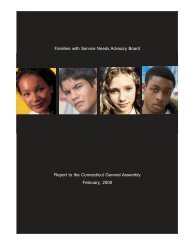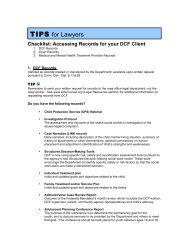Making Court the Last Resort - Center for Children's Advocacy
Making Court the Last Resort - Center for Children's Advocacy
Making Court the Last Resort - Center for Children's Advocacy
You also want an ePaper? Increase the reach of your titles
YUMPU automatically turns print PDFs into web optimized ePapers that Google loves.
“Prior to implementation we had about 300 status offenders insecure detention per year. Since <strong>the</strong> FWSN law was enactedlaunching <strong>the</strong> FSCs, <strong>the</strong>re have been none.”—Kim Sokoloff, Program Manager, <strong>Court</strong> Support Services Divisioncontracts ranging from $400,000 to $550,000 to four private, nonprofit entities to run<strong>the</strong> FSCs. 19Concurrent with <strong>the</strong> investment in <strong>the</strong> FSCs, <strong>the</strong> legislature allocated funding tosupport research and evaluation of <strong>the</strong> state’s new approach to working with statusoffenders. The Justice Research <strong>Center</strong>, a Florida-based organization, was awarded$100,000 to conduct process and outcome evaluations over a two-year period.Like Florida and New York, Connecticut’s approach to serving FWSNs is nowgrounded in <strong>the</strong> philosophy that youth and families in crisis respond best when <strong>the</strong>y areoffered immediate, tailored services in <strong>the</strong>ir communities. Connecticut youth and families,and <strong>the</strong> juvenile justice and child welfare systems, have already begun to benefit fromthis change. Although <strong>the</strong> FSCs are quite new, early data indicates that, <strong>for</strong> <strong>the</strong> first timein more than six years, <strong>the</strong> number of status offenders referred to court, <strong>the</strong> number whocome be<strong>for</strong>e a judge, and <strong>the</strong> number who are housed in secure detention is declining.Between October 2007 and March 2008, after <strong>the</strong> implementation of <strong>the</strong> first four FSCs,<strong>the</strong>re were 1,267 status offense court referrals in <strong>the</strong> state, compared to 2,131 referralsduring <strong>the</strong> same period in <strong>the</strong> prior year— a 41 percent decrease. Moreover, Sokoloffreports that, “prior to implementation of <strong>the</strong> FSCs, we had about 300 status offenders insecure detention per year. Since <strong>the</strong> FWSN law was enacted in 2007 launching <strong>the</strong> FSCs,<strong>the</strong>re have been none.” 20Connecticut stakeholders report that <strong>the</strong> state’s approach to working with childrenat risk of becoming status offenders has evolved in step with <strong>the</strong>se system changes.According to Martha Stone, co-chair of <strong>the</strong> FWSN Advisory Board and director of <strong>the</strong><strong>Center</strong> <strong>for</strong> Children’s <strong>Advocacy</strong> at <strong>the</strong> University of Connecticut School of Law, <strong>the</strong>introduction of <strong>the</strong> FSCs “shifted Connecticut’s policy paradigm. Now we are treatingstatus offenders in a non-punitive, non-criminalized way.”12 <strong>Making</strong> <strong>Court</strong> <strong>the</strong> <strong>Last</strong> <strong>Resort</strong>: A New Focus <strong>for</strong> Supporting Families in Crisis
















